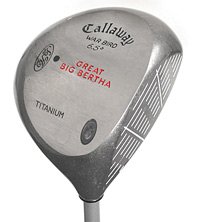|
Nothing beats titanium golf clubs
Until about 1994-1995 titanium drivers were practically unknown in the USA and Europe. They were first introduced by Callaway Golf Company, who wanted to take advantage of the titanium properties, especially the superior weight-to-strength ratio in order to create a really big driver that could allow less skilled players to make the best out of their swings. They were helped by Sturm, Ruger & Company, Inc., engaged principally in the design, manufacture, and sale of firearms for sporting purposes, but who also had a precision casting manufacturing division that was charged with the not so easy task of casting the driver head. The results far exceeded the producer’s expectations. Their first titanium golf driver was called Great Big Bertha – after a WWII German howitzer with an impressively large main gun, and although initial marketing was aimed at the amateur golfer, the pros soon realized the benefits of titanium drivers adding to the titanium success in golf industry.  Many other manufactures have since adopted the use of titanium for manufacturing of golf clubs. The strength of materials really matters in golfing industry because clubs sustain a lot of stress during their normal use on a common course — never mind what frustrated golfers have been known to do to their club when missing the fairway. Titanium resistance to corrosion is an added bonus, and not one to be taken lightly, as increased humidity on a course is a more than likely occurrence.
Many other manufactures have since adopted the use of titanium for manufacturing of golf clubs. The strength of materials really matters in golfing industry because clubs sustain a lot of stress during their normal use on a common course — never mind what frustrated golfers have been known to do to their club when missing the fairway. Titanium resistance to corrosion is an added bonus, and not one to be taken lightly, as increased humidity on a course is a more than likely occurrence.
More importantly, strength-to-weight ratio matters more to golfers. Practically, for any other material, gains in the strength lost to the weight penalty. Besides the obvious critical role weight does play on club's balance and how it influences the golfer swing, there is a more subtle reason behind the importance of a titanium golf clubs strength-to-weight ratio. The lighter, stronger alloys allow increases in the size of the club head without trading off weight. A larger head, in turn, makes for a more forgiving club — one that better resists twisting during off-center strikes. Statistics says there is an 8000 to 1 chance of making a hole in one strike for the common golfer. If you reached that number of hits and still have nothing to tell your wife, neighbors, children, grandchildren and anybody else you know, maybe its time to try a titanium golf club. Return from Titanium golf clubs to Titanium products Return to Titanium Home Page
|


